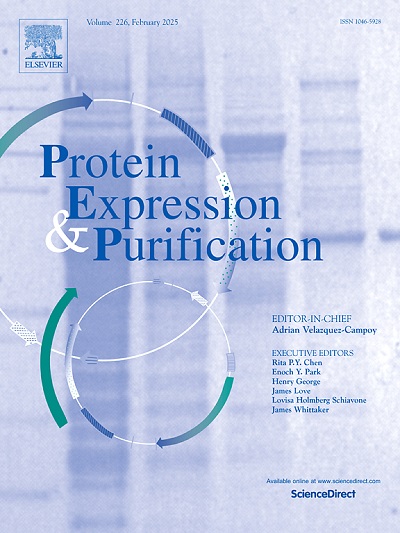Expression and purification of an activated orexin receptor 1- G-protein complex
IF 1.4
4区 生物学
Q4 BIOCHEMICAL RESEARCH METHODS
引用次数: 0
Abstract
Orexin receptors constitute a family of class A G-protein coupled receptors. There are two subtypes of orexin receptors, namely OX1R and OX2R. OX1R and OX2R are widely distributed in the central nervous system and are the targets for the peptide neurotransmitters orexin-A and orexin-B. Orexins are involved in a plethora of key physiological functions such as regulation of the sleep/wake cycle, feeding behavior, energy homeostasis, and cognition. Dysfunction of the orexin system has been linked to various pathological conditions, such as narcolepsy, insomnia, obesity, addiction, cognitive impairment, and depression. The active state structure of OX2R has been elucidated, while the active state structure of OX1R remains unresolved. Here, we describe a method for the expression and purification of an activated OX1R bound to its native peptide ligand, orexin-A, in complex with a Dominant Negative Gsq protein and Nb35. The proteins were expressed in Hi5 insect cells and subsequently purified via two consecutive affinity chromatography steps, followed by a final polishing Size Exclusion Chromatography step. This study could stimulate further research into the activation mechanisms of OX1R and the structural determination of its active state structure.
活化的食欲素受体1- g蛋白复合物的表达和纯化。
食欲素受体是a类g蛋白偶联受体的一个家族。食欲素受体有两个亚型,即OX1R和OX2R。OX1R和OX2R广泛分布于中枢神经系统,是多肽神经递质食欲素- a和食欲素- b的靶点。食欲素参与了许多关键的生理功能,如睡眠/觉醒周期的调节、摄食行为、能量稳态和认知。食欲素系统的功能障碍与各种病理状况有关,如嗜睡症、失眠、肥胖、成瘾、认知障碍和抑郁。OX2R的活性态结构已被阐明,而OX1R的活性态结构仍未解决。在这里,我们描述了一种表达和纯化活化OX1R的方法,该OX1R与天然肽配体orexin-A结合,与显性阴性Gsq蛋白和Nb35复合物结合。这些蛋白在Hi5昆虫细胞中表达,随后通过两个连续的亲和层析步骤纯化,然后进行最后的抛光尺寸排除层析步骤。本研究为进一步研究OX1R的激活机制和确定其活性态结构提供了依据。
本文章由计算机程序翻译,如有差异,请以英文原文为准。
求助全文
约1分钟内获得全文
求助全文
来源期刊

Protein expression and purification
生物-生化研究方法
CiteScore
3.70
自引率
6.20%
发文量
120
审稿时长
32 days
期刊介绍:
Protein Expression and Purification is an international journal providing a forum for the dissemination of new information on protein expression, extraction, purification, characterization, and/or applications using conventional biochemical and/or modern molecular biological approaches and methods, which are of broad interest to the field. The journal does not typically publish repetitive examples of protein expression and purification involving standard, well-established, methods. However, exceptions might include studies on important and/or difficult to express and/or purify proteins and/or studies that include extensive protein characterization, which provide new, previously unpublished information.
 求助内容:
求助内容: 应助结果提醒方式:
应助结果提醒方式:


